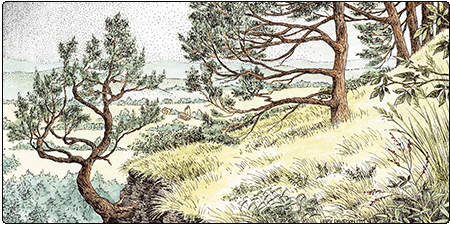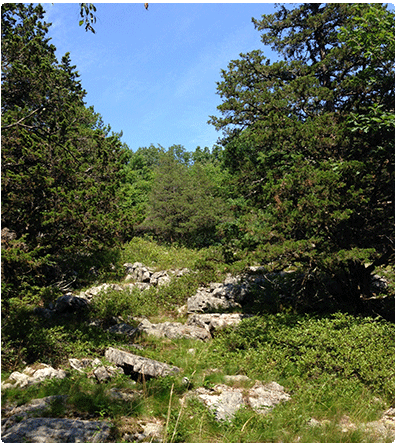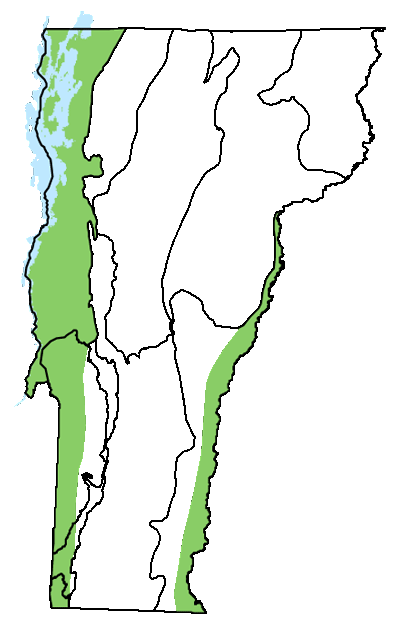Ecology and Physical Setting
A Red Cedar Woodland is a pleasant surprise when exploring the oaky hills of Vermont’s warmer regions. These distinct narrow bands of scattered trees are found on south or west facing clifftops, where they contrast with the closed canopy forest behind them. Like other clifftop communities, these woodlands offer great views of valleys and distant hills. Bedrock ranges from acidic to calcareous. Soils are extremely shallow and well drained, and only the most drought-tolerant plants are able to persist under these conditions. This community typically grades into Dry Oak-Hickory-Hophornbeam Forest or other dry, oak-dominated communities farther back from the edge of the cliff.
Vegetation
Red Cedar Woodland is the only community documented in Vermont where red cedar maintains itself as a dominant species in a mid- to late-successional setting. In these sparse woodlands, red cedars typically hug the cliff edge and have windswept branches that reflect the dominant wind direction. The cedars are slow growing and small trees can be 150 years old or more. Unlike other conifers, whose falling needles acidify soils, the foliage of red cedar concentrates calcium, and the accumulation of red cedar leaf litter raises the soil pH. There is a sparse shrub layer. Hairgrass, poverty grass, and other herbs, along with bryophytes and lichens, may be abundant between areas of exposed bedrock.
 Eastern red cedar is an early-successional old field tree in many parts of the region, especially on clay soils and shallow-to-bedrock soils of the Champlain Valley. These successional areas should not be confused with Red Cedar Woodlands.
Eastern red cedar is an early-successional old field tree in many parts of the region, especially on clay soils and shallow-to-bedrock soils of the Champlain Valley. These successional areas should not be confused with Red Cedar Woodlands.
Wildlife Habitat
The exposed sunny rock of these small cliff-top woodlands provides basking habitat for the rare eastern ratsnake and timber rattlesnake and likely for other more common snakes. Eastern red cedar is one of the host plants for the uncommon juniper hairstreak butterfly. The males perch on red cedar trees waiting for females, which then lay eggs on the tips of the tree branches. The caterpillars eat the red cedar leaves and then the chrysalides spend the winter attached to the trees.
Successional Trends
Drought is the major factor that keeps these communities open and red cedar-dominated. While we often think of warm, dry woodlands being maintained by occasional fire, red cedar is not tolerant of fire. Red cedar woodlands may, in fact, be places that are protected from fire either because of their topographic setting or because there is little accumulation of organic matter to catch fire.
Related Communities
- Temperate Calcareous Outcrop can be adjacent to, or occur as small patches within, Red Cedar Woodland. It is characterized by open rock and less woody vegetation.
- Temperate Acidic Outcrop also can be adjacent to or within Red Cedar Woodland but contains more exposed rock and less woody vegetation.
Conservation Status and Management Considerations
This community is not especially vulnerable to human-induced change since it contains no marketable timber and is generally undevelopable. Owners of this natural community can protect it by allowing natural ecological processes to take place, and by refraining from cutting trees. These are attractive places for picnics, so care should be taken with fire.
Distribution/Abundance
This community is found on clifftops in the warmer regions of the state, including the Taconic Mountains, where it is most abundant, the Champlain Valley, and the Southern Vermont Piedmont. It is known from southern New England as well. Since the conditions that support this community (exposed clifftops) usually occur as small patches, examples of Red Cedar Woodland are themselves small and widely scattered.
Characteristic Plants
Trees
Abundant Species
Eastern red cedar – Juniperus virginiana
Hophornbeam – Ostrya virginiana
Occasional to Locally Abundant Species
Shagbark hickory – Carya ovata
White pine – Pinus strobus
White ash – Fraxinus americana
Red oak – Quercus rubra
Red pine – Pinus resinosa
Black cherry – Prunus serotina
White oak – Quercus alba
Chestnut oak – Quercus montana
Shrubs

small mammals, are often called juniper “berries.”
Occasional to Locally Abundant Species
Downy arrowwood – Viburnum rafinesquianum
Smooth rose – Rosa blanda
Running shadbush – Amelanchier spicata
Low sweet blueberry – Vaccinium angustifolium
Choke cherry – Prunus virginiana
Herbs
Abundant Species
Woodland sedge – Carex pensylvanica
Poverty grass – Danthonia spicata
Cow-wheat – Melampyrum lineare
Little bluestem – Schizachyrium scoparium
Spreading dogbane – Apocynum androsaemifolium
Occasional to Locally Abundant Species
Field pussytoes – Antennaria neglecta
Rusty woodsia – Woodsia ilvensis
Rock sandwort – Minuartia michauxii
Common pinweed – Lechea intermedia
Common woodrush – Luzula multiflora
Hairgrass – Deschampsia flexuosa
Pale corydalis – Capnoides sempervirens
Woodland sunflower – Helianthus divaricatus
Non-native Plants
Canada bluegrass – Poa compressa
Butter-and-eggs – Linaria vulgaris
Rare and Uncommon Plants
Longleaf bluet – Houstonia longifolia
Downy arrowwood – Viburnum rafinesquianum
Bronze sedge – Carex foenea
Dwarf chinquapin oak – Quercus prinoides
Rock spike-moss – Selaginella rupestris
Biltmore hawthorn – Crataegus biltmoreana
Fragrant sumac – Rhus aromatica
Rock muhlenbergia – Muhlenbergia sobolifera
Upland boneset – Eupatorium sessilifolium
Associated Animals
Eastern chipmunk – Tamias striatus
Rare and Uncommon Animals
Eastern ratsnake – Pantherophis alleghaniensis
Timber rattlesnake – Crotalus horridus
Juniper hairstreak – Callophrys gryneus
Places to Visit
Helen W. Buckner Memorial Preserve at Bald Mountain, West Haven, The Nature Conservancy
